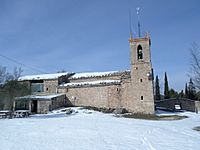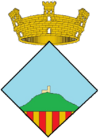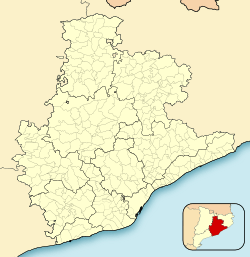Sant Martí de Maçana facts for kids
Quick facts for kids
Maçana
|
||
|---|---|---|
|
Entity of Population
|
||

Church of Sant Martí de Maçana
|
||
|
||
| Country | Spain | |
| Autonomous community | Catalonia | |
| Province | Barcelona | |
| Comarca | Anoia | |
| Area | ||
| • Total | 24 km2 (9 sq mi) | |
| Elevation | 703 m (2,306 ft) | |
| Population
(2014)
|
||
| • Total | 39 | |
| • Density | 1.63/km2 (4.21/sq mi) | |
| Time zone | UTC+1 (CET) | |
| • Summer (DST) | UTC+2 (CEST) | |
Maçana, also known as Sant Martí de Maçana, is a tiny village in the area of Rubió, Catalonia, Spain. It is part of the Anoia region. The village is surrounded by other towns like Aguilar de Segarra and Castellfollit del Boix.
Maçana is found north of the Serra de Rubió mountains. It sits in the valley of the Maçana river, which flows into the Llobregat river. The village grew from different farms built around the old Sant Martí church. In 2014, only 39 people lived here.
Contents
The Story Behind Maçana's Name and Past
The name "Maçana" likely comes from the Latin word Mathiana. This word means "apple." The name was first written down in the year 990. For a long time, until 1980, people also used the spelling "Massana." During the time of Francoist Spain, the village was called San Martín de Masana.
In the 10th century, there was a castle in Maçana. It might have been controlled by someone named Saint Iscle. The old church of Saint Martin was built in the Romanesque style. However, it was completely rebuilt in the 1600s. This means not much of the original Romanesque design is left. In 1840, Maçana became part of the nearby town of Rubió.
Maçana's Coat of Arms
Maçana got its own coat of arms on November 15, 2014. Even though it's not officially recognized by everyone, it's still used. The top part of the coat of arms shows the Maçana Hill. The church of Saint Martin sits on top of this hill. The bottom part features the Senyera, which is the flag of Catalonia.
The Church of Sant Martí de Maçana
The church of Sant Martí de Maçana was first mentioned as a parish in 1154. It was part of the old Maçana castle area, which no longer exists. The church was first dedicated to Saint Martin of Tours. Later, in the 14th century, it was dedicated to Saint Acisclus.
The church has a Latin cross shape inside. Its roof is covered with a pointed vault. Today, the church honors both Saint Martin and Saint Mark. From the outside, the church has a sloped roof. A square bell tower is attached to the church building. The church was repaired between 1975 and 1981. A rectory, which is a house for the priest, is also attached. It was built in 1736. The village cemetery is right next to the church.
Fun Celebrations in Maçana
Maçana has two main traditional parties each year. One is in the spring, and the other is in the autumn.
The autumn celebration happens on the Sunday closest to November 11. This is Saint Martin's day, who is a special patron saint for the church. First, there is a church service. Then, in the afternoon, people enjoy a dance. They also raffle off a special traditional cake called "La Toia."
The spring celebration is bigger. It takes place on the Sunday closest to April 25. This is Saint Mark's day, the church's second patron saint. Again, there's a morning church service. A cake is raffled off, and bread is given out. There's also a classic game called Conill Porquí, which means "guinea pig" in Catalan.
Maçana's Geography and Nature
Maçana is located south of the Alta Segarra region. It sits on the northern side of the Serra de Rubió mountains. The area has very rough land with many valleys. These valleys are part of the Serra de Rubió. The main point of the area is the Turó de Maçana, which is a hill.
The highest point in Rubió is the Còpia de Palomes. It is 837 meters (2,746 feet) tall. This peak is found northwest of Maçana. The Maçana river has several smaller rivers that flow into it from the north of the Serra de Rubió. All these rivers eventually join the Cardener river.
Amazing Animals of Maçana
Maçana is home to many different kinds of animals. You might see wild animals like the boar, the squirrel, and the rabbit. There are also hares, foxes, deer, and roe deer. Many different types of birds also live in the area.
Famous People from Maçana
- Josep Ferrer Bujons: He was a writer, poet, and linguist from Catalonia. He was born in Maçana in 1959.
Images for kids
See also
 In Spanish: Masana para niños
In Spanish: Masana para niños






